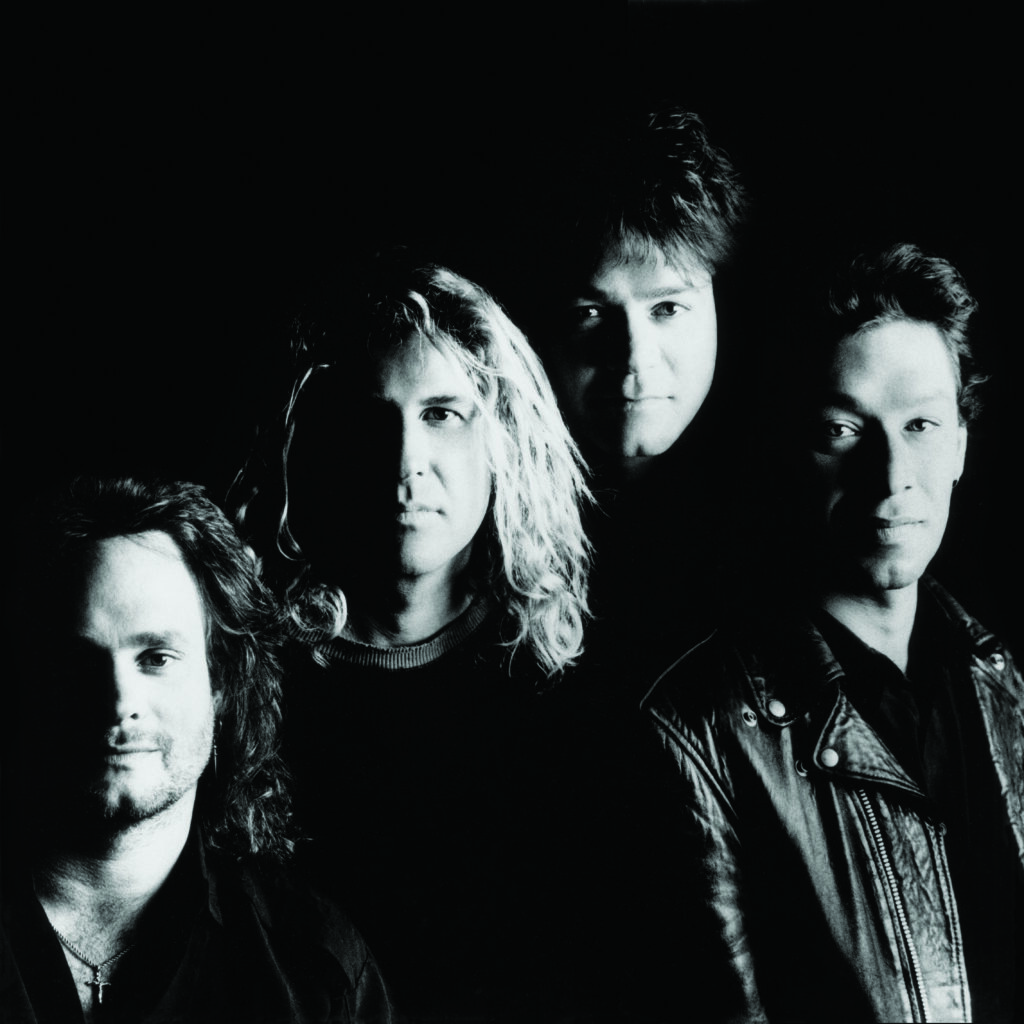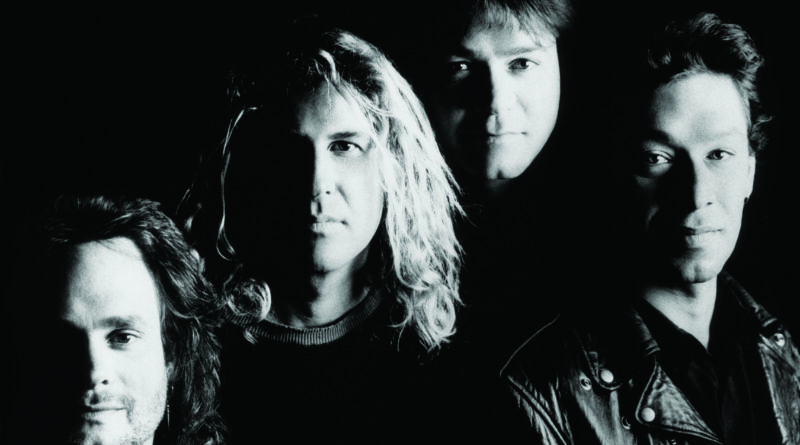HEAVY MUSIC HISTORY: The Van-Hagar Era – Van Halen
“…who’s the other guy that’s singing in VAN HALEN?” So goes the line in 1985, a song made popular by pop-punk phenomenon BOWLING FOR SOUP. It was also the question on many music fans minds in the late 1980’s. 1985 saw the departure of lead singer David Lee Roth, a man whose flamboyant personality epitomised the eighties rock star to a tee. A larger-than-life character who could come up with solid gold quotes such as “Anyone who says money can’t buy you happiness clearly doesn’t know where to shop!”. His vocal style and onstage persona had become as ingrained in the VAN HALEN sound and image as Eddie Van Halen’s two-handed tapping and Frakenstrat guitar. Indeed, many die hard fans were wondering how the band could continue.
Enter the Red Rocker, Sammy Hagar. Already an established and highly regarded musician in his own right thanks to his work with MONTROSE and a stellar solo career. Tracks such as I Can’t Drive 55 and accompanying video putting him front and centre in the rock mainstream of the time. The way Hagar tells it in his 2011 book Red, it was a chance encounter between Eddie and a car mechanic the two had in common, that led to the call between the guitarist and the potential new lead singer. Not a particularly momentous way for two titans of the rock scene to come into contact. As Hagar goes onto recollect, he was not initially inclined to joining the band based on first impressions. However, once the jamming started and ideas started flowing, there was apparently only one outcome. And what an outcome it would prove to be!
“Hello Baby” the opening line of Good Enough from 5150 (1986), our introduction to the now dubbed VAN-HAGAR era. From the moment the album kicks off right through to its concluding Inside, the album represents a rejuvenated VAN HALEN with a powerhouse of intensity in both Eddie and Sammy combining. Reviews were a mixed bag, while many still lauded the guitar work as the centre piece of the band, there were many fans and critics alike lamenting the loss of Roth. Many saw Roth’s strutting bravado deliveries as the missing link connecting the sprawling compositional world of VAN HALEN to the mainstream rock’n’roll world. The presence of Hagar hindered their style and was too straight-faced for VAN HALEN. With the benefit of hindsight, many of those who initially called foul on the 5150 release, have come back to say that it does in fact represent one of the most complete recordings the four-piece ever produced. Whichever side of the fence, it has undeniable energy and tracks such as Why Can’t This Be Love, Dreams, Summer Nights, Love Walks In, and Best Of Both Worlds have entered the pantheon of all-time great rock songs.
Taking it on the road worked a treat. The fresh energy from Hagar brought in a whole new dynamic. While the band mixed in some of Hagar’s solo work; he was not overly keen on singing previous VAN HALEN material. Hagar makes no secret about not being Dave Lee Roth’s biggest fan, he was not enthused about the preexisting catalogue of work. Tracks like Jump were, for him at least, in the past and he wanted to focus on the right here, right now.
Part of Hagar’s deal set by Geffen and negotiated with VAN HALEN’s label, Warner Bros. was to complete a solo album. Hagar’s by now close friend, Eddie was recruited to play bass and produce the album. With this completed, the band reunited for another collective studio outing in the form of OU812 (1988). While some of the lyrical content may not be considered his finest work (looking at you Source Of Infection), there are some shining moments aplenty on this record. When It’s Love stands out particularly. Many would site another change in the band’s style and sound: drummer Al Van Halen was now sober following an intervention after the previous tour. While his strength and determination at getting to sobriety is to rightly be celebrated, there was a difference in him that bled through to his playing. His style was always radical to match his partying lifestyle, but could be erratic. Now, while his timing matched his natural rhythm, he became more conservative. This can definitely be picked up on, but for others to say it changes the style or presence of the overall band, is nonsense. Al was, and still is, a phenomenal drummer, and the fact he listened to advice and got out of a spiral is tremendous.
With a $400,000 video, Poundcake became MTVs Rock Video of The Year for 1991, and the representative of third album For Unlawful Carnal Knowledge (1991). The late eighties had a campaign of censorship spearheaded by the Parents Music Resource Center (PMRC). Many artists, including VAN HALEN, were not fans of the concept. While artists such as Dee Snider and Frank Zappa were more eloquent in their counter arguments VAN HALEN looked to get one up in a more direct way. Record shops worldwide would display the hottest new album from one of the biggest bands, proudly sporting the album’s tagline F.U.C.K.. Poundcake represents an ideal cross section of the album, thunderous rhythm section holding up crushing riffs and banshee vocals. Mixed to get the best out of every aspect the band had to offer. It’s a step up from OU812 and alongside 5150, is arguably not only the best of the VAN HAGAR era, but also the best of VAN HALEN overall. Right Now, with its catchy as anything piano introduction, proved to be a massive hit with radio and live audiences. Top Of The World as a closing statement leaves the listener wanting more. F.U.C.K as an album cements this incarnation of VAN HALEN as a band to be praised.
1995’s Balance would be the studio swansong for this lineup. The writing was on the wall as intense personalities were now in constant friction. Whether Hagar left or was fired, is a matter of perspective and which account one cares to take as gospel. They’d burned bright for the last few years but now it seemed they were burnt out. In the music market, things were shifting. The fresh and exciting grunge had carved a huge market for itself. Like punk from two decades previously, bands that had prided themselves on intricate melodies, all out guitar and drum solos were now battling for popularity. Whilst VAN HALEN still had their legions of fans, the winds were changing. Despite debuting at #1, Balance did not set the world alight. The Seventh Seal did receive a Grammy Nomination but ultimately that’s where the praise ends. The resulting tour saw a band imploding, they gave their all on stage but separate travel and hotel arrangements were the norm. After the tour Hagar and the band would go their separate ways until some years later when tantalising singles popped up on the compilations, but ultimately VAN HAGAR were a dry well from 1995 onwards.
In his 1998 autobiography, Crazy From The Heat, a somewhat bitter sounding Roth reminisced that the music of VAN HALEN prior to his departure, was “morose”. While this maybe an extreme recollection on his part, there was definite lacklustre performances from the band. They had perhaps found themselves in an uninspired rut, with fresh ideas in short supply. What the recently released Sammy Hagar collection illustrates, is that with a new approach and lineup, great things were still achievable for the four-piece. No one could characterise the music from 5150 onwards as morose. Any track from that initial album featuring Hagar, goes toe-to-toe with any track featuring Roth. For Unlawful Carnal Knowledge delivers the epitome of what a great rock band can achieve. Of course, not everything was a smash hit, but there was some undeniably exceptional material produced between 1986 and 1995. During his tenure, Hagar undoubtedly helped steer the ship onto a brighter course.

Like VAN HALEN on Facebook.

